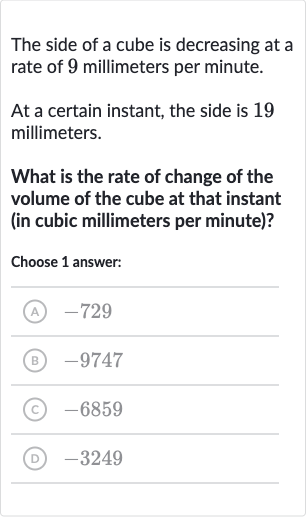AI tutor
Welcome to Bytelearn!
Let’s check out your problem:

The side of a cube is decreasing at a rate of millimeters per minute.At a certain instant, the side is millimeters.What is the rate of change of the volume of the cube at that instant (in cubic millimeters per minute)?Choose answer:(A) (B) (C) (D)
Full solution
Q. The side of a cube is decreasing at a rate of millimeters per minute.At a certain instant, the side is millimeters.What is the rate of change of the volume of the cube at that instant (in cubic millimeters per minute)?Choose answer:(A) (B) (C) (D)
- Volume formula: Volume of a cube formula is , where is the side length.
- Differentiate volume: Differentiate the volume with respect to time to find the rate of change of volume, .
- Plug in values: Plug in the values: and .
- Calculate : Calculate .
- Simplify calculation: Simplify the calculation: .
- Multiply for rate: Multiply to find the rate of change: .
- Final calculation: Final calculation:
More problems from Calculate unit rates with fractions
QuestionGet tutor help
QuestionGet tutor help
QuestionGet tutor help
QuestionGet tutor help
QuestionGet tutor help
QuestionGet tutor help
QuestionGet tutor help
QuestionGet tutor help
QuestionGet tutor help
